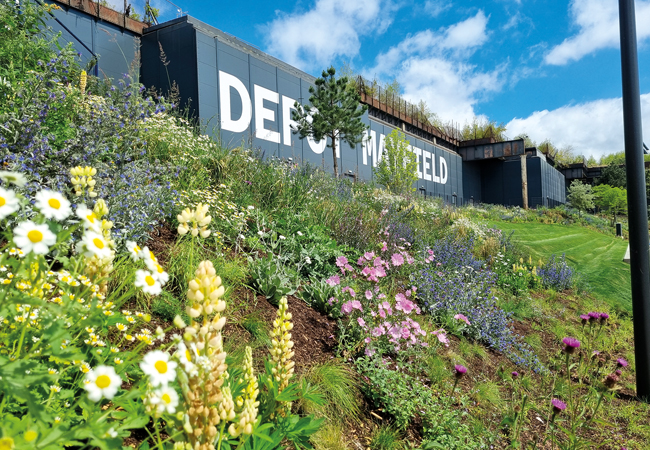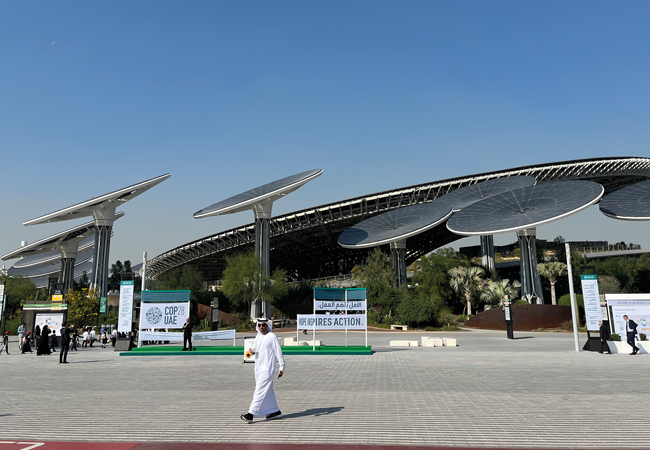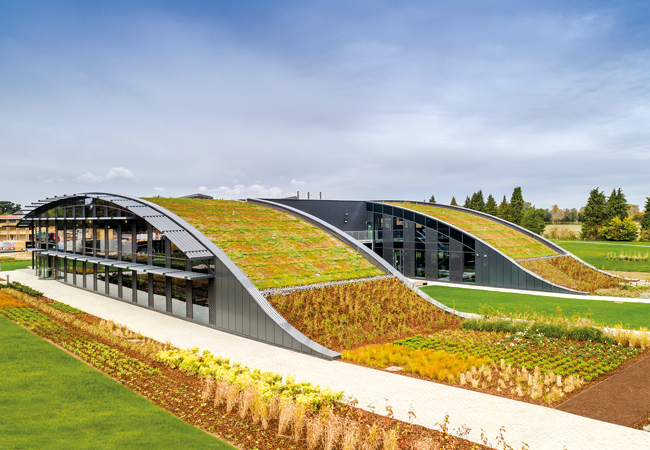
Green landscaping supports the delivery of climate-resilient development by providing climate mitigation and adaptation benefits. The new headquarters for CABI, in Wallingford, incorporates nature into the building design to align with the CABI’s mission to use bioscience to solve global environmental challenges
We are in a climate and biodiversity emergency, two interlinked crises with local and global impacts being felt today. Increasingly, reducing dependence on fossil fuels has become a key priority for businesses, governments and people across the world. A catalyst for this was the 2015 Paris Agreement, adopted by more than 90 countries, which set a clear and shared goal of pursuing efforts to limit global warming to 1.5K.
Many consultants in the built environment – including engineers, architects, project managers and landscape architects – have signed up to the international declaration of the climate and biodiversity emergency.1 In the UK alone, more than 120 companies have joined the Building Services Engineers Climate and Biodiversity Emergency Declaration.2 This is a commitment to collaborate, share knowledge and advocate increased resource efficiency on projects and more regenerative design principles.
The importance of biodiversity has not come under the same spotlight as decarbonisation, but we are on the cusp of change. At the World Economic Forum in 2020, a new global ambition was born: ‘nature positive by 2030’. This is viewed as the biodiversity equivalent of the Paris Climate agreement. A driving force behind this shift in focus is nature’s unprecedented freefall; since 1970, the relative abundance of monitored wildlife populations has declined by 69%. This figure was 60% five years ago.3
The need for designers to be more aware of the role of protecting and incorporating nature in building development was also recognised at a recent annual conference of the UK Building Services Engineers Climate and Biodiversity Emergency .4
The need to protect and restore biodiversity
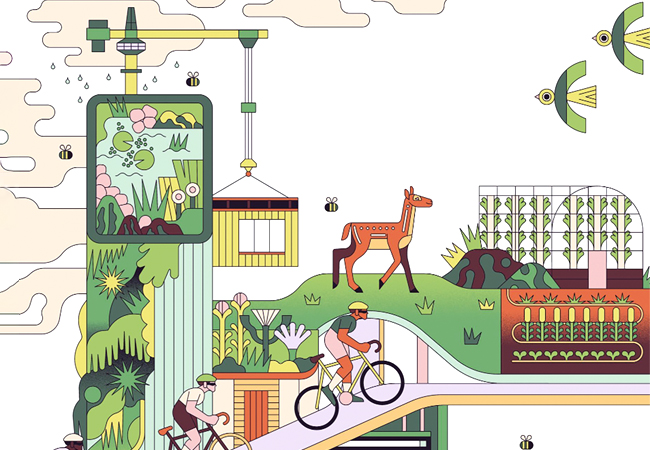
Over their lifetime, nature-based solutions actively pull carbon out of the atmosphere
At the most basic level of reasoning, nature must be protected and restored because it is fundamental to our survival. Our natural world provides the clean air, food and water we need to thrive; it enhances our wellbeing and reduces threats of zoonotic diseases.
Nature’s services to us – otherwise known as ecosystem services – are near infinite, and include everything from climate regulation, pollution reduction, medicinal plants, construction materials, and eco-tourism.
In the UK built environment, a radical transformation is under way to revalue nature. This is, in part, spurred by national regulations that, from November 2023, will require all developments under the Town and Country Planning Act to create a 10% biodiversity net gain – something that many local authorities already require to be exceeded. (Small sites will have to meet the target in April 2024).
This legal mandate is encouraging developers and asset owners to seek out the multifunctional benefits associated with nature. Beyond planning requirements, organisations have, since May 2023, been able to set science-based targets for nature, similar to their carbon equivalent. This approach gives companies a clear structure to protect and restore nature in line with science.
Science based targets for nature
Science-based targets for nature (SBTN) – developed by the Science Based Targets Network, a collaboration of global non-profits and other organisations – are designed to help organisations measure and address environmental impacts across the supply chain, using the best possible science available.
The targets focus on impacts on the environment that organisations should avoid and reduce – such as deforestation and pollution – as well as positive impacts, including watershed restoration and the rehabilitation of degraded land.
Land and freshwater targets that support biodiversity are the first action areas that SBTN are making available for companies to set targets against, to reduce their negative impacts and increase positive outcomes for nature and people. The first methods help firms address their impacts across their direct operations and upstream supply chains.
This includes technical guidance for organisations to assess and prioritise their impacts on freshwater quality (specific to nitrogen and phosphorus) and freshwater quantity. The guidance for land targets are designed to protect and restore ecosystems.
SBTN are similar to the Science Based Targets initiative (SBTi), launched in 2015 as a collaboration between a partnership between CDP, the United Nations Global Compact, World Resources Institute and the World Wide Fund for Nature (WWF), which helps companies reduce their emissions in line with climate science. SBTi provides the framework and tools for companies to set science-based net zero targets and limit global temperature rise above pre-industrial levels to 1.5K.
Sector-specific targets have been developed for a number of industries, including power, cement, and financial institutions. In May, draft guidance was published for the building sector: see bit.ly/CJJul23SBT.
Green infrastructure
Nature-based solutions provide green infrastructure such as green walls, biodiverse roofs, gardens, parks, and sustainable urban drainage systems, which have social, economic and environmental benefits. To date, engineers haven’t fully incorporated these solutions in their toolboxes, but – if used at scale – they offer a means of reducing the risks of the climate and biodiversity emergencies.
As building solutions, they not only have a low – or, in some cases, negative – embodied carbon impact, but over their lifetime actively pull carbon out of the atmosphere. Furthermore, focusing on nature-based solutions results in an uplift to site biodiversity.
Modern developments typically target a wide spectrum of outcomes to ensure they deliver against various stakeholder expectations. Because of their diverse range of benefits, nature-based solutions are becoming an increasingly more cost-effective way to deliver on these priorities.
Green roofs are an increasingly common nature-based solution, particularly in urban areas with scarce space. 1 New Street Square, London, the Centre for Agriculture and Bioscience International (CABI) HQ in Wallingford, Oxfordshire, and the University of Greenwich Library are examples of developments that have embraced green roofs as part of their design. In addition to their basic function of providing shelter, these roofs are outcompeting their traditional alternatives by improving building performance and occupant experience.
One significant benefit of a green roof is its ability to alleviate some of the urban heat island affect by shading heat-storing hard surfaces and absorbing solar radiation through evaporation and evapotranspiration. This reduces internal and external air temperature by, on average, 4K and 1K respectively. Green roofs can also, on average, reduce noise by 11dB, increase property value by 6.9% and store 73% of rainwater runoff.
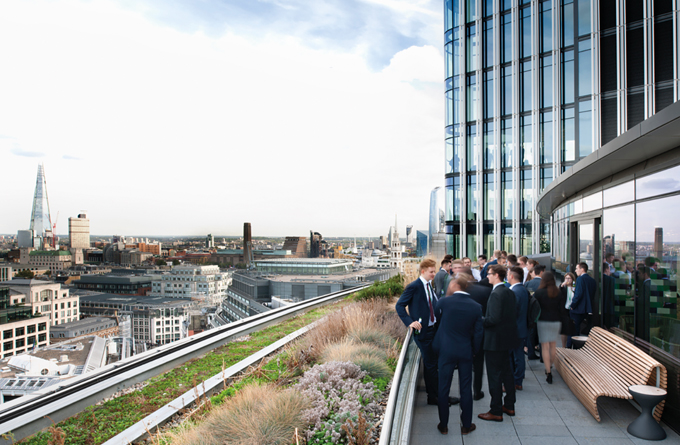
The biodiverse roof terrace at 1 New Street Square, in the city of London, provides microclimate and biophilic benefits for the occupants of this office building for Deloitte
Quantifying nature’s value
Nature’s economic, environmental and social value has historically been hard to quantify. For this reason, nature has struggled to be fully used in building design. An ambitious masterplan in west London is being used as a test bed for creating an approach to help quantify the value of a landscape-led development.
For this, a Defra Natural Capital Tool has been produced, using data from a meta-study of scientific papers to build a value profile for each nature-based solution type. These profiles enable landscape strategies to be appraised on how they contribute to the attainment of the development’s sustainability targets, business priorities and wider value creation. The aim is to influence and support decisions around landscaping design based on the desired attributes being sought.
Take a typical masterplan containing a busy high street with lots of pedestrians and road noise, for example. Priorities might include reducing the risk of pedestrians overheating in summer, decreasing noise pollution for building occupants, and avoiding flood risk. The tool could be used to identify the mix of nature-based solutions to optimise delivery against these priorities. For instance, it would identify that trees, on average, reduce air temperature by 3K, can absorb 4dB of sound, and reduce rainwater runoff by 43%. Trees also contribute to net zero targets by sequestering carbon, and help attract retail tenants by increasing people’s willingness to spend in local businesses by 30%.
Nature-based solutions can also return financial value. Last year, the UK Green Building Council (UKGBC) released a report that outlines how nature-based solutions can be the basis for financial benefits and new revenue streams.5
Takeaway
Nature-based solutions can be viewed by engineers as an extension to their toolbox of approaches. In practice, they will probably require new cross-discipline working partnerships, to tap into the expertise of landscape architects, ecologists and sustainability consultants to apply solutions to real-world projects.
- Robert Winch is a senior consultant and Ashley Bateson a director, both at Hoare Lea, and Chin Chen is a senior associate at Grant Associates.
References:
- www.builtenvironmentdeclares.com
- www.buildingservicesengineersdeclare.com
- Almond R E A, Grooten M, Juffe Bignoli D and Petersen T, Living Planet Report 2022 – Building a nature positive society, WWF, Switzerland
- www.linkedin.com/company/uk-building-services-engineers-declare
- The value of urban nature-based solutions, UKGBC, May 2022, bit.ly/CJNatUKGBC



